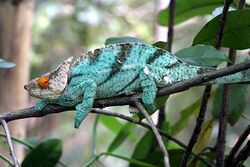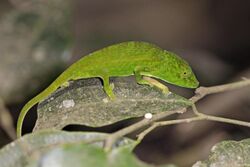Biology:Calumma
| Calumma | |
|---|---|

| |
| Calumma parsonii | |
| Scientific classification | |
| Domain: | Eukaryota |
| Kingdom: | Animalia |
| Phylum: | Chordata |
| Class: | Reptilia |
| Order: | Squamata |
| Suborder: | Iguania |
| Family: | Chamaeleonidae |
| Subfamily: | Chamaeleoninae |
| Genus: | Calumma Gray, 1865 |
| Type species | |
| Chamaeleon cucullatus Gray, 1831
| |
| Diversity | |
| 41 species | |
Calumma is a genus of chameleon (a type of highly adapted and specialised lizard) endemic to the island of Madagascar . One species, formerly known as Calumma tigris (the Seychelles tiger chameleon), was transferred to the genus Archaius in 2010, upon the discovery of its closer relation to Rieppeleon—one of several genera referred to collectively as "leaf" or "pygmy" chameleons—rather than to Calumma.[1] The earliest known fossil of the genus is of Calumma benovskyi, from early Miocene Kenya, showing that the genus likely originated on mainland East Africa.[2] The genus includes one of the heaviest and longest chameleon species, the Parson's chameleon (Calumma parsonii).[3]
Species groups
Four species groups are recognised within the genus Calumma (originally proposed by Glaw & Vences in 1994[4]), some of which may be only phenetic, while others are phylogenetically supported:[5][6]
Calumma furcifer species group
Contents: Calumma furcifer, C. gastrotaenia, C. marojezense, C. guillaumeti, C. andringitraense, C. glawi, C. vencesi
Species characterised by typically green body colouration, sleek body form, and generally no occipital lobes (flaps of skin posterior to the head; present only in C. glawi) and no rostral appendage (present only in males of C. furcifer).[4]
Calumma cucullatum species group
Contents: Calumma cucullatum, C. crypticum, C. amber, C. tsaratananense, C. hafahafa, C. hilleniusi, C. peltierorum, C. malthe, C. brevicorne, C. jejy, C. tsycorne
Species characterised by distinct occipital lobes and generally a single bony rostral appendage that is larger in males than females.[4]
Calumma nasutum species group
Contents: Calumma nasutum, C. fallax, C. gallus, C. guibei, C. boettgeri, C. linotum, C. gehringi, C. uetzi, C. lefona, C. juliae, C. vatosoa, C. vohibola, C. peyrierasi, C. roaloko
Species characterised by a soft dermal rostral appendage (generally present in males and absent in females).[4] The following members possess occipital lobes: C. guibei, C. boettgeri, C. linotum, C. gehringi, C. uetzi, C. lefona, C. roaloko, and C. juliae.[7][8] These taxa are collectively referred to as the C. guibei species complex.[5][7] Occipital lobes are absent from all other species.[4] The assignment of C. peyrierasi to this group remains a subject of uncertainty.[9]
Calumma parsonii species group
Contents: Calumma globifer, C. ambreense, C. oshaughnessyi, C. parsonii, C. capuroni
Species characterised by large body size, males with paired rostral appendages, and some species with small occipital lobes.[4]
Species
The following 41 species are recognized as being valid as of October 2020:
- Calumma amber Raxworthy & Nussbaum, 2006 – Amber Mountain chameleon
- Calumma ambreense (Ramanantsoa, 1974)
- Calumma andringitraense (Brygoo, C. Blanc & Domergue, 1972)
- Calumma boettgeri (Boulenger, 1888) – Boettger's chameleon
- Calumma brevicorne (Günther, 1879) – short-horned chameleon
- Calumma capuroni (Brygoo, C. Blanc & Domergue, 1972) – Madagascar chameleon
- Calumma crypticum Raxworthy & Nussbaum, 2006 – blue-legged chameleon
- Calumma cucullatum (Gray, 1831) – hooded chameleon
- Calumma emelinae Prötzel, Scherz, Ratsoavina, Vences & Glaw, 2020
- Calumma fallax (Mocquard, 1900) – deceptive chameleon
- Calumma furcifer (Vaillant & Grandidier, 1880) – forked chameleon
- Calumma gallus (Günther, 1877) – blade chameleon
- Calumma gastrotaenia (Boulenger, 1888) – Perinet chameleon
- Calumma gehringi Prötzel, Vences, Scherz, Vieites & Glaw, 2017
- Calumma glawi Böhme, 1997 – Glaw's chameleon
- Calumma globifer (Günther, 1879) – globe-horned chameleon or flat-casqued chameleon
- Calumma guibei (Hillenius, 1959) – Guibe's chameleon
- Calumma guillaumeti (Brygoo, C. Blanc & Domergue, 1974)
- Calumma hafahafa Raxworthy & Nussbaum, 2006 – bizarre-nosed chameleon
- Calumma hilleniusi (Brygoo, C. Blanc & Domergue, 1973)
- Calumma jejy Raxworthy & Nussbaum, 2006 – Marojejy Peak chameleon
- Calumma juliae Prötzel, Vences, Hawlitschek, Scherz, Ratsoavina & Glaw, 2018
- Calumma lefona Prötzel, Vences, Hawlitschek, Scherz, Ratsoavina & Glaw, 2018
- Calumma linotum (L. Müller, 1924) – Amber Mountain blue-nosed chameleon
- Calumma malthe (Günther, 1879) – yellow-green chameleon
- Calumma marojezense (Brygoo, C. Blanc & Domergue, 1970)
- Calumma nasutum (A.M.C. Duméril & Bibron, 1836) – big-nosed chameleon, pimple-nose chameleon
- Calumma oshaughnessyi (Günther, 1881) – O'Shaughnessy's chameleon
- Calumma parsonii (Cuvier, 1824) – Parsons's chameleon
- Calumma peltierorum Raxworthy & Nussbaum, 2006 – Peltier's chameleon
- Calumma peyrierasi (Brygoo, C. Blanc & Domergue, 1974) – Brygoo's chameleon, Peyriéras's chameleon[10]
- Calumma radamanus (Mertens, 1933)
- Calumma ratnasariae Prötzel, Scherz, Ratsoavina, Vences & Glaw, 2020[11]
- Calumma roaloko Prötzel, Lambert, Andrianasolo, Hutter, Cobb, Scherz & Glaw, 2018 – Two-toned soft-nosed chameleon[8]
- Calumma tarzan Gehring, Pabijan, Ratsoavina, J. Köhler, Vences & Glaw, 2010 – Tarzan chameleon, Tarzan's chameleon
- Calumma tjiasmantoi Prötzel, Scherz, Ratsoavina, Vences & Glaw, 2020
- Calumma tsaratananense (Brygoo & Domergue, 1967) – Tsaratanana chameleon
- Calumma tsycorne Raxworthy & Nussbaum, 2006 – blunt-nosed chameleon
- Calumma uetzi Prötzel, Vences, Hawlitschek, Scherz, Ratsoavina & Glaw, 2018 – Uetz's soft-nosed chameleon
- Calumma vatosoa Andreone, Mattioli, Jesu & Randrianirina, 2001
- Calumma vencesi Andreone, Mattioli, Jesu & Randrianirina, 2001 – Vences's chameleon
- Calumma vohibola Gehring, Ratsoavina, Vences & Glaw, 2011
Nota bene: A binomial authority in parentheses indicates that the species was originally described in a genus other than Calumma.
References
- ↑ "Eastward from Africa: palaeocurrent-mediated chameleon dispersal to the Seychelles islands". Biology Letters 7 (2): 225–228. 2010. doi:10.1098/rsbl.2010.0701. PMID 20826471.
- ↑ Čerňanský, Andrej; Herrel, Anthony; Kibii, Job M.; Anderson, Christopher V.; Boistel, Renaud; Lehmann, Thomas (December 2020). "The only complete articulated early Miocene chameleon skull (Rusinga Island, Kenya) suggests an African origin for Madagascar's endemic chameleons" (in en). Scientific Reports 10 (1): 109. doi:10.1038/s41598-019-57014-5. ISSN 2045-2322. PMID 31924840. Bibcode: 2020NatSR..10..109C.
- ↑ Vitt, Laurie. "Chameleon". https://www.britannica.com/animal/chameleon-reptile#ref1159147. Retrieved 26 August 2023. "The longest chameleon in the world is Parson’s chameleon (Calumma parsonii), which may grow up to 69.5 cm (about 27 inches) long."
- ↑ 4.0 4.1 4.2 4.3 4.4 4.5 Glaw, Frank; Vences, Miguel (1994). A Fieldguide to the Amphibians and Reptiles of Madagascar, Second Edition. Cologne, Germany: Vences & Glaw Verlags GbR / Serpents Tale. 480 pp. ISBN 978-3929449-01-3.
- ↑ 5.0 5.1 Prötzel, David; Vences, Miguel; Scherz, Mark D.; Vieites, David R.; Glaw, Frank (2017). "Splitting and lumping: An integrative taxonomic assessment of Malagasy chameleons in the Calumma guibei complex results in the new species C. gehringi sp. nov.". Vertebrate Zoology 67 (2): 231–249. doi:10.3897/vz.67.e31591. http://www.senckenberg.de/files/content/forschung/publikationen/vertebratezoology/vz67-2/10_vertebrate_zoology_67-2_proetzel_231-249.pdf.
- ↑ Tolley, Krystal A.; Townsend, Ted M.; Vences, Miguel (2013-05-22). "Large-scale phylogeny of chameleons suggests African origins and Eocene diversification" (in en). Proceedings of the Royal Society of London B: Biological Sciences 280 (1759): 20130184. doi:10.1098/rspb.2013.0184. ISSN 0962-8452. PMID 23536596.
- ↑ 7.0 7.1 Prötzel, David; Vences, Miguel; Hawlitschek, Oliver; Scherz, Mark D.; Ratsoavina, Fanomezana M.; Glaw, Frank (2018). "Endangered beauties: micro-CT cranial osteology, molecular genetics and external morphology reveal three new species of chameleons in the Calumma boettgeri complex (Squamata: Chamaeleonidae)" (in en). Zoological Journal of the Linnean Society 184 (2): 471–498. doi:10.1093/zoolinnean/zlx112.
- ↑ 8.0 8.1 Prötzel, David; Lambert, Shea M.; Andrianasolo, Ginah Tsiorisoa; Hutter, Carl R.; Cobb, Kerry A.; Scherz, Mark D.; Glaw, Frank (2018-10-19). "The smallest 'true chameleon' from Madagascar: a new, distinctly colored species of the Calumma boettgeri complex (Squamata, Chamaeleonidae)" (in en). Zoosystematics and Evolution 94 (2): 409–423. doi:10.3897/zse.94.27305. ISSN 1860-0743.
- ↑ Prötzel, David; Ruthensteiner, Bernhard; Glaw, Frank (2016-08-01). "No longer single! Description of female Calumma vatosoa (Squamata, Chamaeleonidae) including a review of the species and its systematic position" (in en). Zoosystematics and Evolution 92 (1): 13–21. doi:10.3897/zse.92.6464. ISSN 1860-0743.
- ↑ Beolens, Bo; Watkins, Michael; Grayson, Michael (2011). The Eponym Dictionary of Reptiles. Baltimore: Johns Hopkins University Press. xiii + 296 pp. ISBN:978-1-4214-0135-5. (Calumma peyrierasi, p. 205).
- ↑ Prötzel, David; Scherz, Mark D.; Ratsoavina, Fanomezana M.; Vences, Miguel; Glaw, Frank (2020). "Untangling the trees: Revision of the Calumma nasutum complex (Squamata: Chamaeleonidae)". Vertebrate Zoology 70 (1). doi:10.26049/VZ70-1-2020-3. https://www.researchgate.net/publication/339029391.
Further reading
- Gray JE (1865). "Revision of the Genera and Species of Chamæleonidæ, with the Descriptions of some New Species". Proc. Zool. Soc. London 1864: 465–479. (Calumma, new genus, p. 476).
External links
- Anderson CV (2006). Captive Chameleon Populations. Accessed 23-01-2009[|permanent dead link|dead link}}]
Wikidata ☰ Q135860 entry
 |


